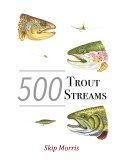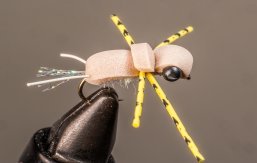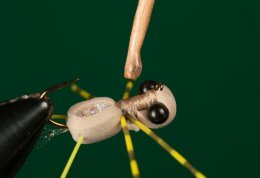Turck Tarantula Tying Steps
(The Turck Tarantula, Part 2)
In this section, Turck Tarantula Tying Steps, Skip takes you step-by-step through the construction of this challenging pattern.
First, the pattern:
Turck Tarantula
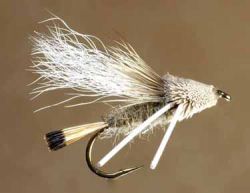 The Turck Tarantula
The Turck Tarantula
Hook: Heavy wire (or standard or light), 3X (or 2X) long, sizes 12 to 4.
Thread: Tan 3/0. (I use size-A rod-thread for the hair head.)
Tail: Golden pheasant tippet.
Body: Hare's mask (or tan-brown synthetic dubbing).
Wing: White calf tail with one strand (or more) of pearl Krystal Flash on each side.
Over-wing: Natural Deer hair.
Legs: White or brown medium-diameter round rubber-strand.
Head: Natural tan-brown deer hair.
Second, a few tips to help you master tying the Tarantula:
- 1. The body should be full—feel free to spin lots of dubbing onto your thread, and to wind the dubbing-covered thread up and down
the shank two, even three times.
- 2. The dubbing itself is hare's mask, if you stick with the pattern, but I prefer tan or light-brown synthetic dubbing—Poly
dubbing, Antron...—because synthetic fibers are more buoyant than fur.
- 3. If you mount the legs as I describe in the photos and captions, they'll tend to sweep back, especially if you create a tightly packed head.
- 4. If you want the legs out more to the sides, bind them on about two-thirds up the body, short of the wing-head area.
And finally, before you start tying, a primer on tying spun deer-hair heads:
Building the head is standard hair-flaring procedure—if you don't know how to flare deer hair, lots of tying books and videos out there can help.
Basically, this is how I do it:
- 1. I work a bunch of hair down around the shank; wrap two turns of heavy thread around the bunch; hold the bunch firmly in place
as I tighten the thread; draw back all the hair-ends in front, and then pull the thread firmly forward and secure it in a few tight wraps.
- 2. I bind second, perhaps even a third, bunch in front of the first in this manner, pushing each bunch back into the last.
- 3. I whip finish the thread at the eye, trim the thread, and then shape the head with scissors or a razor blade. (Handle razor blades
with great care!)
- 4. However you trim the head, make sure you hold the legs back out of the way—
there is no way to replace the legs if you cut them off.
Turck Tarantula Tying Steps:
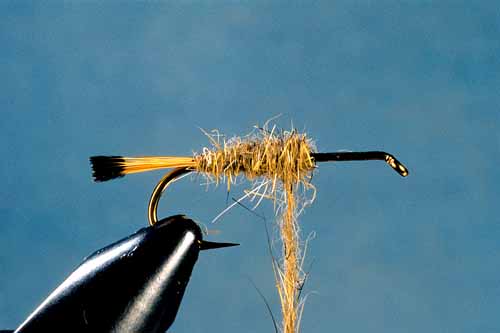 Step 1
Step 1
1. Start the thread. Bind on a section of golden pheasant tippet for a tail; the tail's length should equal the hook's gape. Dub a full, tapered body up about two-thirds of the hook's shank.
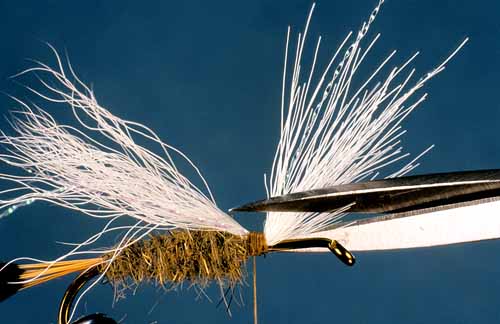 Step 2
Step 2
2. Cut from the hide, comb, and stack a modest bunch of white calf-tail hair. Bind the hair atop the shank right in front of the body.
The tips of the wing-hairs should terminate over the tip of the tail.
Bind one strand of Krystal Flash on either side of the wing. Trim the butts of the Krystal Flash and the butts of the hair to a short angle, and then bind them.
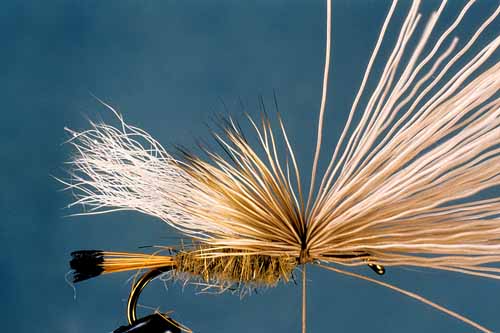 Step 3
Step 3
3. Cut from the hide, comb, and stack a modest bunch of deer hair.
Bind the hair atop the calf hair.
The tips of the deer should project back as a short top wing, reaching only to about the rear of the body.
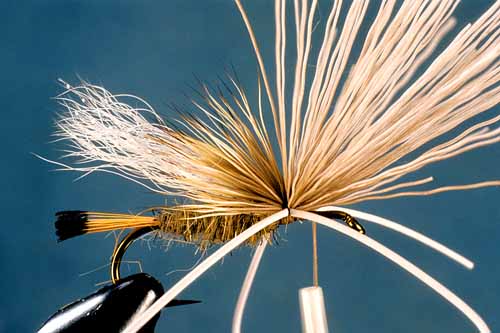 Step 4
Step 4
4. Loop a short length of rubber strand over the thread and slide it down to the near side of the hook, where the deer is bound.
Secure the strand with a few tight thread-turns. Bind another strand on the opposite side in the same manner.
Now the half-finished fly should appear to have four long legs.
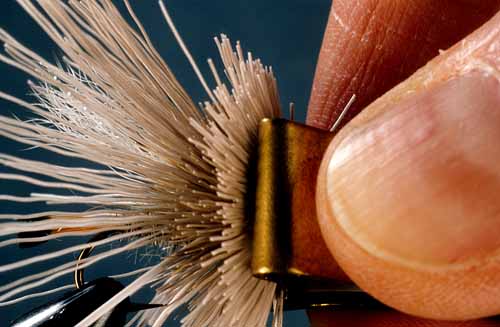 Step 5
Step 5
5. Flare deer hair up the remainder of the shank to the hook's eye. (No need to stack these bunches—they'll all be cut down anyway.)
Compress each bunch of hair back into the last with thumb and finger or a hair-compressing tool.
Whip finish the thread or make several half hitches. Cut the thread.
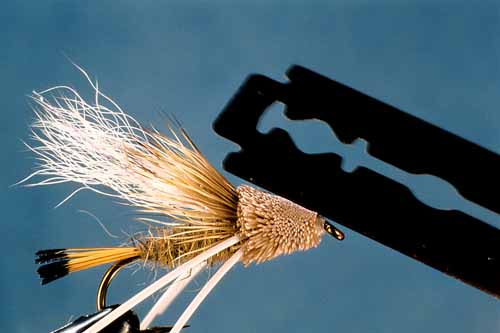 Step 6
Step 6
6. With scissors, razor blade, or both, shape the head to tapering out from the eye, rounded over the top, fairly flat beneath. Hold the legs out
of the way as you trim.
When the head is finished, pull the legs out to the sides. Trim the legs to about equal the length of the hook's shank. (You can make them a little longer
than this, however, if you want a spidery look.)
Add head cement to the whip finish or half hitches securing the thread.
And that completes the Turck Tarantula tying steps.
In the previous article,The Turck Tarantula, Part 1, fly fishing author and tying authority Skip Morris discusses the origin and effectiveness of this
popular attractor fly.
Click here to hear Skip's interviews on popular podcasts...
*Announcements*
Skip has an essay in Big Sky Journal's annual Fly Fishing issue, called "Montana Hoppers: the Princess and the Brute" released February 1, 2023. Skip rewrote it a bit; I painted and illustrated it here, on our website. Here's the link on our web page to check it out:
Click here to read Skip's essay Montana Hoppers: The Princess and the Brute...
Skip's latest books:
Top 12 Dry Flies for Trout Streams: How, When, and Where to Fish Them, is now available on Amazon as an ebook...check it out! Click on the links below to go to the information page on Top 12 Dry Flies (the link to Amazon is at the bottom of the page...)
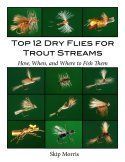 Top 12 Dry Flies for Trout Streams: How, When, and Where to Fish Them
Top 12 Dry Flies for Trout Streams: How, When, and Where to Fish Them
Click here to get more information about
Top 12 Dry Flies for Trout Streams: How, When, and Where to Fish Them (the link to Amazon is at the bottom of the page)...
Top 12 Dry Flies for Trout Streams: How, When, and Where to Fish Them (the link to Amazon is at the bottom of the page)...
Top 12 Nymphs for Trout Streams: How, When, and Where to Fish Them, 2nd Edition, originally published as an e-book only, is now available on Amazon as a paperback...check it out! Click on the links below to go to the information page on Top 12 Nymphs (the link to Amazon is at the bottom of the page...)
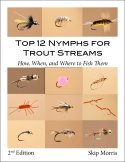 Top 12 Nymphs for Trout Streams: How, When, and Where to Fish Them (2nd Edition)
Top 12 Nymphs for Trout Streams: How, When, and Where to Fish Them (2nd Edition)
Click here to get more information about
Top 12 Nymphs for Trout Streams: How, When, and Where to Fish Them (2nd Edition). . .
Top 12 Nymphs for Trout Streams: How, When, and Where to Fish Them (2nd Edition). . .
Click here to get more information about Skip's e-book,
500 Trout Streams...
500 Trout Streams...
Skip's latest paperback book:
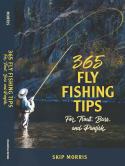 365 Fly Fishing Tips for Trout, Bass, and Panfish
365 Fly Fishing Tips for Trout, Bass, and Panfish
Click here to get more information about Skip's latest book,
365 Tips for Trout, Bass, and Panfish...
365 Tips for Trout, Bass, and Panfish...
Print Skip's chart for FREE:
Skip Morris's Trout-Fly Proportion Chart
Go to Skip Morris's Trout Fly Proportion Chart
Skip's Predator is available to buy...
Skip's ultra-popular Predator—a hit fly for bluegills and other panfishes and largemouth bass (also catches smallmouth bass and trout)—is being tied commercially by the Solitude Fly Company.
The Predator
CLICK HERE to learn more about or to purchase the Predator...
Learn to Tie Skip's Predator
Do you want to tie the Predator?
Tying the Predator
Skip shows you how to tie it on his YouTube Channel link, listed below:
CLICK HERE to see Skip's detailed video on how to tie the Predator...






